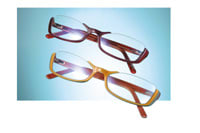eye
on equipment
Edging
Challenges Answered
by Susan P. Tarrant
Push a button and go. This is the claim of many a modern edger, and for the most part, it's correct. Technology has taken away the need for fine machining skills and operator manipulation and replaced it with ease-of-use features that can handle any material, any design, and any problem. Well, nearly any problem.
While challenging edging jobs are becoming a thing of the past, there are still some lens situations that require a little something extra. Here, our equipment experts provide some tips to get operators through the hard parts.
SAFETY VS. AESTHETICS
PROBLEM: How can I balance safety and aesthetics when working with children's lenses?
SOLUTION: It's important to follow the general rule of safety first. When prescribing for children, the lens material of choice has long been polycarbonate (although Trivex is also gaining popularity).
Polycarbonate has a relatively high index of refraction. Therefore, a high minus lens can still be finished in an aesthetically pleasing look in a standard center thickness. You can even surface the material down to a 1.0 center thickness without sacrificing safety. Almost all of the newer edgers have the ability to dry-cut poly, and the edges can be polished beautifully.
As for Trivex, I hear differing opinions on the best way to edge it. Some use dry-cut, others wet-cut. Our machines have a Trivex setting that uses a slower wheel rotation and a mix of dry and wet cutting.
Operators need to be mindful of working with a small lens. They need to block as much on geometric center as possible to maximize the cut-out potential. When edging small lenses, it helps to use a good half-eye block.
Thomas Fefer, ABOC, FNAO, sales manager, Western U.S., Santinelli International
|
|
|
|
Newer machines can generally handle small lenses thanks to the popularity of small frames. Shown: OWP style 2100 |
TOO SMALL TO FIT?
PROBLEM: I'm worried that the small lenses I edge aren't fitting correctly in my edger. Am I doing something wrong?
SOLUTION: Neither of the materials that are generally prescribed for kids--polycarbonate and Trivex--creates an issue with modern edgers. But, small eyesizes are difficult to trace. Some customers have to modify the chucks and blocks (literally taking scissors and a grinding stone to the chuck and block). That can produce a mismatch between the chuck, block, and pad, which can result in a flexing of the lens. That can cause the qualities of the lens to change.
The newer edging machines are generally built to handle small eyesizes, so you're going to get a nice, tight fit without risking that flex.
Small lenses for adults have been the trend for some time, so many companies have modified their equipment designs accordingly.
The good news is, even if the adult trends go back to larger sizes, the machine will edge children's sizes forever.
Todd Rhodes, director of product management, Gerber Coburn
CONTROLLING ILLUMINATION
PROBLEM: I can't see the lens markings on sunlenses.
SOLUTION: This is a common problem when working with dark lenses, especially polarized sunlenses. I can't stress enough the need to have a blocker that allows control of illumination so that you can see the optical reference points, such as the bifocal segment, progressive marks, or lensometer marks.
While we're on the topic, it is important when processing polarized lenses to have the 180 degree line lined up correctly.
If this is not done, the effectiveness of the polarization is reduced dramatically.
Matt Vulich, vice president, sales/marketing, AIT Industries
SMALL B, SMALL PROBLEMS
PROBLEM: Do I need to edge lenses with small "B" measurements differently?
SOLUTION: Always make sure that you use a smaller chuck and block for edging small lenses.
Otherwise, there is a risk that a larger chuck will run down into the wheel, causing damage to the edger and lens. Using a half-eye block and a small chuck will enable you to handle small lenses without damaging them.
The ideal is to use a patternless edger that has automatic settings designed for edging small "B" measurements. Some edgers will prompt the operator to change to a smaller chuck when needed.
Rob McCoy, service director, Briot-WECO USA




